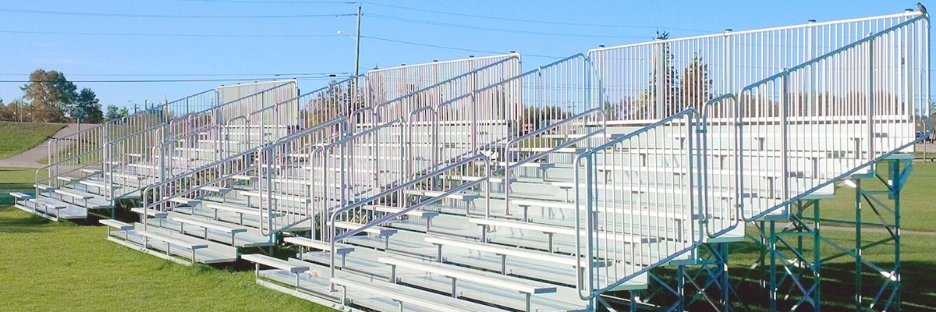Bleachers are a crucial part of any stadium or outdoor event venue. They provide seating for spectators while maximizing space utilization. However, proper design specifications are crucial to ensure safety, functionality, and compliance with building codes and regulations. This article will provide a comprehensive guide to bleacher design specifications and related considerations.
Understanding Bleacher Design
Structural Components
This includes the framework and support system of the bleachers. The framework can be made of steel, aluminum, or other materials, and it provides the structural support for the bleachers. The support system includes the footings and anchors that secure the bleachers to the ground.
Decking and Flooring Materials
The decking is the surface on which the spectators sit, and it can be made of wood, aluminum, or composite materials. The flooring materials must be durable, weather-resistant, and slip-resistant.
Railing and Guardrail Requirements
The railing and guardrail requirements are essential for safety. The height and spacing of the rails and guardrails must be in compliance with local, state, and national building codes and regulations.
Seating Arrangements
The seating arrangements can be either bench-style or individual seats. The seating capacity must be determined based on the available space and the needs of the spectators.
Bench Style vs. Individual Seats
Bench-style seating is more space-efficient and can accommodate more spectators, but individual seats provide greater comfort and flexibility.
Spacing and Capacity Considerations
The spacing and capacity must be determined based on the available space and the needs of the spectators. The seating capacity must be in compliance with local, state, and national building codes and regulations.
Accessibility for People with Disabilities
The bleachers must be accessible for people with disabilities. This includes wheelchair-accessible seating, ramps, and handrails.

Safety and Code Compliance
Building codes and regulations govern bleacher design and construction. Local, state, and national requirements must be met. The Americans with Disabilities Act (ADA) accessibility guidelines must also be followed. Design considerations for safety and structural integrity are essential. Weight limits and load distribution are also crucial factors. Guardrails, handrails, anti-slip surfaces, and safety netting are examples of safety features.
Customization and Additional Features
Portable and tip and roll bleachers are additional options available. These types of bleachers can easily be transported and stored when not in use, making them a great option for venues with limited space or those that require flexibility in seating arrangements. In addition, these types of bleachers are often less expensive than permanent bleachers, making them a cost-effective choice for smaller venues or events.

Conclusion
Proper design specifications, compliance with building codes and regulations, structural integrity, and material selection are crucial considerations when designing bleachers. Customization and additional features, such as team colors and logos, can also enhance the spectator experience. This guide provides a comprehensive overview of bleacher design and related considerations, making it a valuable resource for anyone involved in the design or construction of bleachers for stadiums or outdoor event venues.

FAQ
Q. What are the ADA requirements for bleacher design?
The Americans with Disabilities Act (ADA) requires that bleachers be accessible for people with disabilities. This includes wheelchair-accessible seating, ramps, and handrails. The guidelines specify the number of wheelchair spaces required and the location and spacing of these spaces. In addition, there are requirements for the slope and rise of the bleacher seating and the height and width of the aisles and steps.
Q. How do I determine the seating capacity for bleachers?
The seating capacity for bleachers must be determined based on the available space and the needs of the spectators. It is important to make sure that the seating capacity is in compliance with local, state, and national building codes and regulations. Factors to consider when determining seating capacity include the width of the bleachers, the spacing between rows, the number of seats per row, and the total number of rows. It is recommended to consult with a professional and knowledgeable Furniture Leisure associate to determine the appropriate seating capacity for your specific needs.
Q. Which materials are best for durability in outdoor environments?
The best materials for durability in outdoor environments are those that are weather-resistant and able to withstand exposure to the elements. Some examples of durable materials for bleacher construction include aluminum, steel, and composite materials. It is important to choose materials that are able to maintain their structural integrity over time and resist corrosion or damage from weather conditions.
Q. Are there specific regulations for guardrail heights?
Yes, there are specific regulations for guardrail heights. The height and spacing of the rails and guardrails must be in compliance with local, state, and national building codes and regulations to ensure safety. The regulations vary depending on the location and intended use of the bleachers. It is important to consult with a knowledgeable bleacher supplier to ensure compliance with all applicable regulations and guidelines.
Q. How often should I inspect and maintain bleachers?
Bleachers should be inspected and maintained regularly to ensure safety and compliance with building codes and regulations. The frequency of inspections and maintenance will depend on factors such as the frequency of use, the age of the bleachers, and the environmental conditions in which they are located.
People also ask, can you rent bleachers? Learn more now!


















































































































Leave your comment